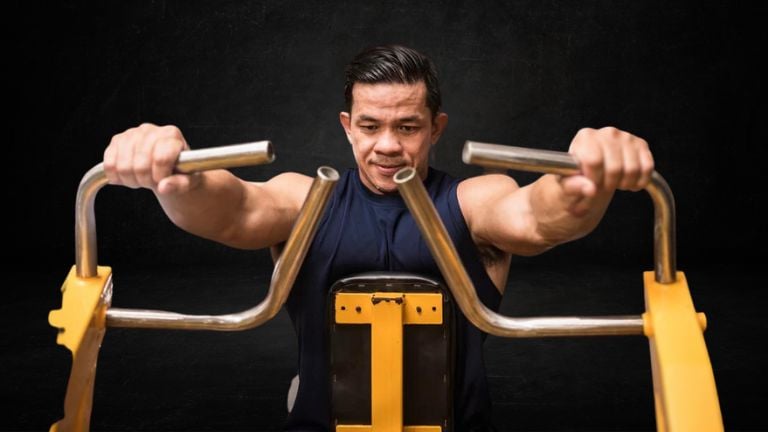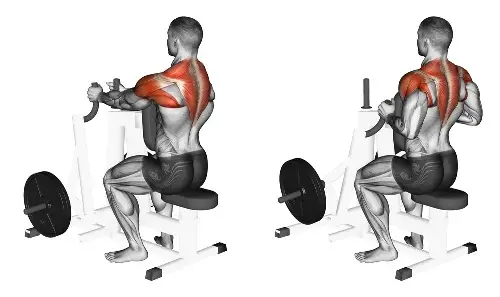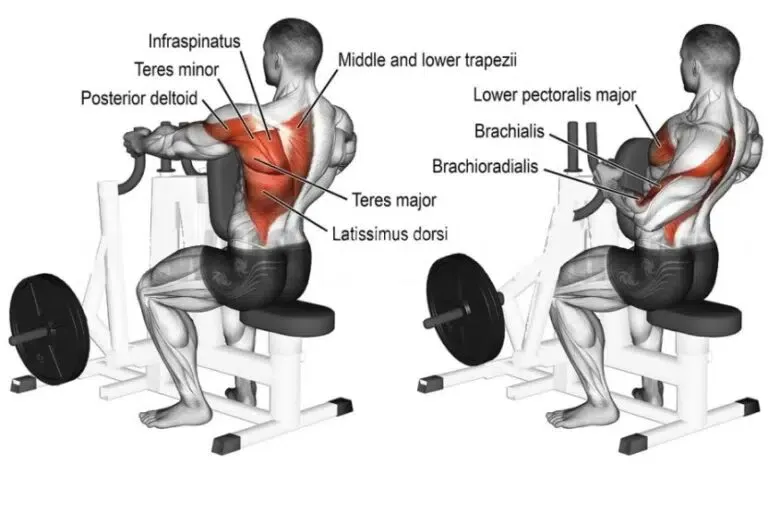Do you want to build a strong, V-shaped back and improve your rowing power? Then the seated machine back row is a must-have exercise in your back workout routine.
As more fitness enthusiasts seek workouts that are both challenging and effective, the chest supported machine Row stands out as both a challenge and a solution.
We will talk about the Seated Machine Back Row exercise in this blog, including the muscles that are worked, how to do, and common mistakes to avoid.

- What Seated Machine Back Row
- Muscles Worked By The Seated Machine Back Row
- How To Do Chest Supported Back Row
- Position Yourself on the Machine
- Grip the Handles
- Set Your Posture
- Execute the Row
- Return to Start
- Common Mistakes to Be Avoid
- Variations and Progression
- 1. Changing Grip
- 2. Single-Arm Rows for Unilateral Training
- 3. Progressively Overload
- 4. Add Drop Sets
- 5. Compound Sets
- Alternatives to the Seated Machine Back Row
- 1. Seated Cable Row
- 2. Landmine Row
- 3. Barbell Row
- 4. Single-Arm Dumbbell Row
- Conclusion
What Seated Machine Back Row
The Seated machine back row also known as chest supported row is a strength training exercise that primarily targets the muscles of the upper and middle back.
The Chest Supported Machine Row is a specialized gym equipment designed to isolate your back muscles while providing support to your chest and torso.
This machine is an excellent option for those who have lower back issues or simply want to focus exclusively on their upper back muscles, since it minimizes the strain on your lower back.
The equipment usually consists of a padded chest support, a seat, and handlebars or grips connected to a weight stack or plates. You will typically be able to use an underhand grip, overhand grip, neutral grip, close grip, and wide grip.

Want to take your gains to the next level? Discover your daily calorie needs with our free TDEE calculator
Muscles Worked By The Seated Machine Back Row
The seated machine row is a great exercise for strengthening the muscles in your back. It primarily targets the latissimus dorsi (lats), but it also works the rhomboids, teres major, and biceps brachii.
- Latissimus dorsi (lats): the largest muscles in your back. They are responsible for pulling your arms down and back.
- Rhomboids: help to stabilize your shoulder blades.
- Posterior Deltoid: It also works when you do machine row.
- Teres major: helps to rotate your arm inwards.
- Biceps brachii: The biceps brachii is a muscle in the front of your upper arm. It helps to bend your arm at the elbow.
- Brachialis: Located underneath the biceps, this muscle also aids in elbow flexion.
- Brachioradialis: This is a muscle of the forearm that assists in flexing the elbow.
In addition to these muscles, the chest supported machine row can also work the trapezius, and forearms.

How To Do Chest Supported Back Row
Proper form is important for maximizing muscle engagement during the Seated Machine Back Row. Here’s a step-by-step guide on how to perform this exercise correctly.
Position Yourself on the Machine
- Adjust the seat height so your feet can comfortably rest on the platform or footrests, and your chest aligns with the chest pad.
- Secure your feet firmly on the footrests with knees slightly bent.
Grip the Handles
- Lean forward and grasp the machine’s handles.
- Most row machines will offer two grip options – wide grip or neutral grip. Choose based on your preference.
Set Your Posture
- Sit up straight with a neutral spine. Your chest should be pressing lightly against the chest pad.
- Your head should be aligned with your spine – neither looking too far up nor down.
- Engage your core. Imagine drawing your navel toward your spine to ensure your core remains tight.
Execute the Row
- Start by pulling your elbows back towards you.
- As you pull, focus on squeezing your shoulder blades together.
- Ensure the movement is initiated from the back and not just the arms.
- Continue pulling the handles toward your torso until your elbows are just past your body.
- At the peak of the contraction, your back muscles should be fully engaged.

Return to Start
- Slowly release the handles forward in a controlled manner. Allow your back muscles to stretch as you return to the initial position.
- Do not let the weight stack crash down. Maintain a constant resistance throughout the entire range of motion.
Common Mistakes to Be Avoid
- Overarching the Back: Maintain a neutral spine, avoiding excessive arching or rounding.
- Arm Dominance: Relying too much on the arms instead of initiating the pull with the back muscles.
- Incomplete Range of Motion: Not fully extending the arms at the start or not squeezing the shoulder blades together at the end of the row.
- Using Momentum: Jerking the weight or using body momentum rather than a controlled, smooth motion.
- Incorrect Neck Position: Craning the neck forward or looking too far up/down, which can strain the cervical spine.
- Excessive Weight: Loading too much weight that compromises form.
- Not Engaging the Core: Failing to keep the core muscles tight and supportive throughout the exercise.
- Bent Wrists: Keeping the wrists flexed or extended instead of maintaining a neutral, straight position.
Variations and Progression
The seated machine row can be changed up to keep workouts fresh, target muscles in a different way, and allow for continued growth and strength gains.
1. Changing Grip
- Overhand Grip (Pronated): With palms facing down, this grip will place a little more emphasis on the upper lats and rear deltoids.
- Underhand Grip (Supinated): With palms facing up, this grip shifts the focus slightly more toward the lower lats and engages the biceps more intensely.
- Wide vs. Narrow Grip: Different handle attachments or hand spacings can emphasize various parts of the back. A wider grip targets the outer lats more, while a narrower grip focuses on the mid-back.
2. Single-Arm Rows for Unilateral Training
The row can be done one arm at a time to address muscle imbalances and ensure one side isn’t compensating for the other.
Single-arm machine rows often allow a deeper pull, further engaging the targeted muscles.
3. Progressively Overload
Gradually increasing the weight over time ensures that your muscles consistently adapt, grow, and gain strength. However, always prioritize form over weight.
4. Add Drop Sets
After completing a set at a heavier weight, immediately reduce the weight and perform another set. This method intensifies the workout and induces greater muscle fatigue.
5. Compound Sets
Pair the seated row with another back exercise, such as a lat pulldown, and perform them back-to-back with minimal rest in between.
Alternatives to the Seated Machine Back Row
There are several effective alternatives to the Seated Machine Back Row that can target similar muscle groups.
1. Seated Cable Row
Seated Cable Rows are an excellent cable exercise to build middle back muscles, and this also works on the lower back as well.
This back exercise is done on a cable rowing machine with separate handles and grip position change, the muscle worked involvement.
2. Landmine Row
If you are looking to add freshness and variety to your back workouts and give yourself a new challenge, give this landmine row exercise a try.
Landmine row training and the exercises you can perform are empowering, and extremely beneficial. It’s an important part of your back workout.
3. Barbell Row
The barbell row is a compound barbell exercise that targets the major muscles of the back, including the latissimus dorsi (lats), rhomboids, and trapezius.
It is a classic exercise that has been used by bodybuilders and powerlifters for decades.
4. Single-Arm Dumbbell Row
One arm dumbbell row is a strength training exercise that primarily targets the muscles in your back, including your lats, rhomboids, and trapezius.
It is performed by holding a dumbbell in one hand while keeping your other hand and knee on a bench or stable surface. And then pulling the weight towards your chest while maintaining proper form and control.
Conclusion
The seated machine row is an effective exercise for strengthening the upper body and improving posture.
It targets the major muscles of the back, including the latissimus dorsi (lats), rhomboids, and trapezius. It is an easy exercise to learn and can be performed by people of all fitness levels.

Manish brings over 10 years of hands-on experience in weight lifting and fat loss to fitness coaching. He specializes in gym-based training and has a lot of knowledge about exercise, lifting technique, biomechanics, and more.
Through “Fit Life Regime,” he generously shares the insights he’s gained over a decade in the field. His goal is to equip others with the knowledge to start their own fitness journey.
